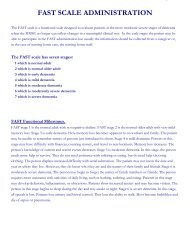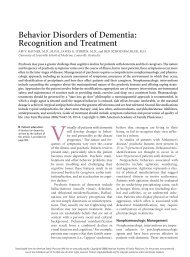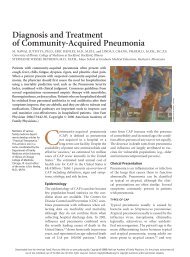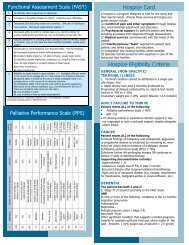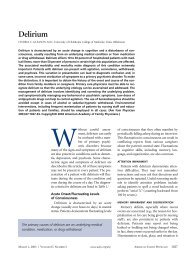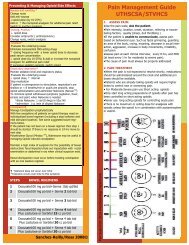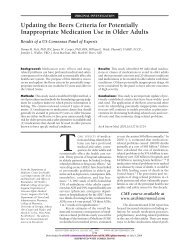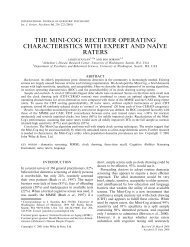Administration of the CLOX: Clock Drawing Executive Test ©Royall ...
Administration of the CLOX: Clock Drawing Executive Test ©Royall ...
Administration of the CLOX: Clock Drawing Executive Test ©Royall ...
You also want an ePaper? Increase the reach of your titles
YUMPU automatically turns print PDFs into web optimized ePapers that Google loves.
<strong>the</strong> task unfolds, both anticipating (placing <strong>the</strong> 12, 6, 3, and 9 first) and/or correcting errors as<strong>the</strong>y occur.It is just as important to note what a patient does not do during a clock-drawing task. Our <strong>CLOX</strong>form and its verbal instructions have been designed to tempt <strong>the</strong> patient into, stronglyassociated but irrelevant behaviors. The circle in <strong>the</strong> left lower corner is irrelevant to clockdrawingwhen viewed from <strong>the</strong> back side <strong>of</strong> <strong>the</strong> form, but it tempts <strong>the</strong> patient to place <strong>the</strong>irclock within its image. We chose <strong>the</strong> words "hand" and "face because <strong>the</strong>y are more stronglyassociated with body parts than clock elements, and may trigger semantic intrusions from <strong>the</strong>irmore common meanings. The number " 4'5 " does not appear on a typical clock face, and mayintrude into <strong>the</strong> patient's construction in <strong>the</strong> form <strong>of</strong> a digital image (1:45) or hands pointing to<strong>the</strong> 4 or 5 o' clock positions. Of <strong>the</strong> 15 available <strong>CLOX</strong> points, 13 rate <strong>the</strong> presence <strong>of</strong> subjectchosen elements. Three points reflect <strong>the</strong> inhibition <strong>of</strong> irrelevant distractions, <strong>the</strong> anticipation<strong>of</strong> potential spacing errors, and <strong>the</strong>ir monitoring or correction. <strong>CLOX</strong> scores range from 0-15.Lower scores. reflect greater impairment.The <strong>CLOX</strong>'s second step is a simple copying task. The examiner allows <strong>the</strong> patient to observehim or her drawing a clock in <strong>the</strong> circle provided on <strong>the</strong> scoring sheet. The examiner sets <strong>the</strong>hands again to "1:45", places <strong>the</strong> 12,6,3, and 9 first, and makes <strong>the</strong> hands into arrows. Thepatient is allowed to copy <strong>the</strong> examiner's clock. Score this clock as "<strong>CLOX</strong> 2".



